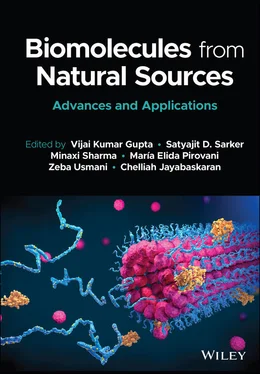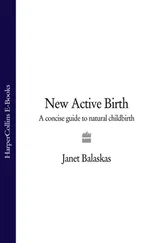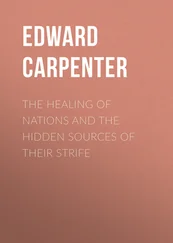Biomolecules from Natural Sources
Здесь есть возможность читать онлайн «Biomolecules from Natural Sources» — ознакомительный отрывок электронной книги совершенно бесплатно, а после прочтения отрывка купить полную версию. В некоторых случаях можно слушать аудио, скачать через торрент в формате fb2 и присутствует краткое содержание. Жанр: unrecognised, на английском языке. Описание произведения, (предисловие) а так же отзывы посетителей доступны на портале библиотеки ЛибКат.
- Название:Biomolecules from Natural Sources
- Автор:
- Жанр:
- Год:неизвестен
- ISBN:нет данных
- Рейтинг книги:5 / 5. Голосов: 1
-
Избранное:Добавить в избранное
- Отзывы:
-
Ваша оценка:
- 100
- 1
- 2
- 3
- 4
- 5
Biomolecules from Natural Sources: краткое содержание, описание и аннотация
Предлагаем к чтению аннотацию, описание, краткое содержание или предисловие (зависит от того, что написал сам автор книги «Biomolecules from Natural Sources»). Если вы не нашли необходимую информацию о книге — напишите в комментариях, мы постараемся отыскать её.
An up-to-date exploration of new and novel biomolecules Biomolecules from Natural Sources: Advances and Applications,
Biomolecules from Natural Sources: Advances and Applications
Natural Sources: Advances and Applications
Biomolecules from Natural Sources — читать онлайн ознакомительный отрывок
Ниже представлен текст книги, разбитый по страницам. Система сохранения места последней прочитанной страницы, позволяет с удобством читать онлайн бесплатно книгу «Biomolecules from Natural Sources», без необходимости каждый раз заново искать на чём Вы остановились. Поставьте закладку, и сможете в любой момент перейти на страницу, на которой закончили чтение.
Интервал:
Закладка:
166 166 Monteiro, O.A., Jr. and Airoldi, C. (1999). Some thermodynamic data on copper-chitin and copper-chitosan biopolymer interactions. Journal of Colloid and Interface Science 212 (2): 212–219.
167 167 Zhu, A., Zhang, M., and Shen, J. (2003). Covalent immobilization of O-butyrylchitosan with a photosensitive hetero-bifunctional crosslinking reagent on biopolymer substrate surface and bloodcompatibility characterization. Journal of Biomaterials Science. Polymer Edition 14 (5): 411–421.
168 168 Kim, D., Petrisor, G., and Yen, T.F. (2005). Evaluation of biopolymer-modified concrete systems for disposal of cathode ray tube glass. Journal of the Air and Waste Management Association 55 (7): 961–969.
169 169 Kim, D., Quinlan, M., and Yen, T.F. (2009). Encapsulation of lead from hazardous CRT glass wastes using biopolymer cross-linked concrete systems. Waste Management 29 (1): 321–328.
170 170 Gils, P.S., Ray, D., and Sahoo, P.K. (2009). Characteristics of xanthan gum-based biodegradable superporous hydrogel. International Journal of Biological Macromolecules 45 (4): 364–371.
171 171 Cortes, H., Caballero-Floran, I.H., Mendoza-Munoz, N., Escutia-Guadarrama, L., Figueroa-Gonzalez, G., Reyes-Hernandez, O.D., Gonzalez-Del Carmen, M., Varela-Cardoso, M., Gonzalez-Torres, M., Floran, B., Del Prado-Audelo, M.L., and Leyva-Gomez, G. (2020). Xanthan gum in drug release. Cellular and Molecular Biology (Noisy-le-grand) 66 (4): 199–207.
172 172 Alves, A., Miguel, S.P., Araujo, A., de Jesus Valle, M.J., Sanchez Navarro, A., Correia, I.J., Ribeiro, M.P., and Coutinho, P. (2020). Xanthan Gum-Konjac glucomannan blend hydrogel for wound healing. Polymers (Basel) 12 (1): 99.
173 173 Byram, P.K., Sunka, K.C., Barik, A., Kaushal, M., Dhara, S., and Chakravorty, N. (2020). Biomimetic silk fibroin and xanthan gum blended hydrogels for connective tissue regeneration. International Journal of Biological Macromolecules 165 (Pt A): 874–882.
174 174 Dzionek, A., Wojcieszynska, D., Adamczyk-Habrajska, M., Karczewski, J., Potocka, I., and Guzik, U. (2021). Xanthan gum as a carrier for bacterial cell entrapment: developing a novel immobilised biocatalyst. Materials Science and Engineering C: Materials for Biological Applications 118: 111474.
175 175 Castro, G.R., Panilaitis, B., and Kaplan, D.L. (2008). Emulsan, a tailorable biopolymer for controlled release. Bioresource Technology 99 (11): 4566–4571.
176 176 Ebert, K.H. and Schenk, G. (1968). Mechanisms of biopolymer growth: the formation of dextran and levan. Advances in Enzymology and Related Areas of Molecular Biology 30: 179–221.
177 177 van Oss, C.J. (1989). Energetics of cell-cell and cell-biopolymer interactions. Cell Biophysics 14 (1): 1–16.
178 178 Maciollek, A. and Ritter, H. (2014). One pot synthesis of silver nanoparticles using a cyclodextrin containing polymer as reductant and stabilizer. Beilstein Journal of Nanotechnology 5: 380–385.
179 179 Chen, L., Li, J., Ye, Z., Sun, B., Wang, L., Chen, Y., Han, J., Yu, M., Wang, Y., Zhou, Q., Seidler, U., Tian, D., and Xiao, F. (2020). Anti-high mobility group Box 1 neutralizing-antibody ameliorates dextran sodium sulfate colitis in mice. Frontiers in Immunology 11: 585094.
180 180 Bonnaud, M., Weiss, J., and McClements, D.J. (2010). Interaction of a food-grade cationic surfactant (lauric arginate) with food-grade biopolymers (pectin, carrageenan, xanthan, alginate, dextran, and chitosan). Journal of Agricultural and Food Chemistry 58 (17): 9770–9777.
181 181 Spyropoulos, F., Ding, P., Frith, W.J., Norton, I.T., Wolf, B., and Pacek, A.W. (2008). Interfacial tension in aqueous biopolymer-surfactant mixtures. Journal of Colloid and Interface Science 317 (2): 604–610.
182 182 Haghighatpanah, N., Mirzaee, H., Khodaiyan, F., Kennedy, J.F., Aghakhani, A., Hosseini, S.S., and Jahanbin, K. (2020). Optimization and characterization of pullulan produced by a newly identified strain of Aureobasidium pullulans. International Journal of Biological Macromolecules 152: 305–313.
183 183 Ganeshkumar, M., Ponrasu, T., Raja, M.D., Subamekala, M.K., and Suguna, L. (2014). Green synthesis of pullulan stabilized gold nanoparticles for cancer targeted drug delivery. Spectrochimica Acta Part A: Molecular and Biomolecular Spectroscopy 130: 64–71.
184 184 Shingel, K.I. (2004). Current knowledge on biosynthesis, biological activity, and chemical modification of the exopolysaccharide, pullulan. Carbohydrate Research 339 (3): 447–460.
185 185 Morris, A., Hillenbrand, M., Finkelman, M., George, M.P., Singh, V., Kessinger, C., Lucht, L., Busch, M., McMahon, D., Weinman, R., Steele, C., Norris, K.A., and Gingo, M.R. (2012). Serum (1>3)-β-D-glucan levels in HIV-infected individuals are associated with immunosuppression, inflammation, and cardiopulmonary function. JAIDS Journal of Acquired Immune Deficiency Syndromes 61 (4): 462–468.
186 186 Araujo, D., Alves, V.D., Marques, A.C., Fortunato, E., Reis, M.A.M., and Freitas, F. (2020). Low temperature dissolution of yeast chitin-glucan complex and characterization of the regenerated polymer. Bioengineering (Basel) 7 (1).
187 187 Wang, H., Chen, G., Li, X., Zheng, F., and Zeng, X. (2020). Yeast beta-glucan, a potential prebiotic, showed a similar probiotic activity to inulin. Food and Function 11 (12): 10386–10396.
188 188 Pornanek, P. and Phoemchalard, C. (2020). Dietary supplementation of beta-glucan-rich molasses yeast powder on antibody response to swine fever virus and hematology of starter-grower pigs. Tropical Animal Health and Production 53 (1): 43.
189 189 Huang, H., Liu, Y., and Liu, R. (2009). Sphingomonas sp.: an important microbial resource for biopolymer synthesis. Wei Sheng Wu Xue Bao 49 (5): 560–566.
190 190 Matyshevskaia, M.S., Gvozdiak, R.I., Maiko, I.I., Lipkes, M.I., and Dedusenko, G. (1979). Biopolymer produced by bacteria of the genus Xanthomonas and its use in the petroleum industry. Mikrobiologicheskii Zhurnal 41 (1): 88–92.
191 191 Tolstoguzov, V. (2002). Thermodynamic aspects of biopolymer functionality in biological systems, foods, and beverages. Critical Reviews in Biotechnology 22 (2): 89–174.
192 192 Zhong, J., Frases, S., Wang, H., Casadevall, A., and Stark, R.E. (2008). Following fungal melanin biosynthesis with solid-state NMR: biopolymer molecular structures and possible connections to cell-wall polysaccharides. Biochemistry 47 (16): 4701–4710.
193 193 Zhu, C., Lee, J.H., Raghavan, S.R., and Payne, G.F. (2006). Bioinspired vesicle restraint and mobilization using a biopolymer scaffold. Langmuir 22 (7): 2951–2955.
194 194 Recuenco, F.C., Kobayashi, K., Ishiwa, A., Enomoto-Rogers, Y., Fundador, N.G.V., Sugi, T., Takemae, H., Iwanaga, T., Murakoshi, F., Gong, H., Inomata, A., Horimoto, T., Iwata, T., and Kato, K. (2014). Gellan sulfate inhibits Plasmodium falciparum growth and invasion of red blood cells in vitro. Scientific Reports 4 (1).
195 195 Ding, Y., Jiang, F., Chen, L., Lyu, W., Chi, Z., and Liu, C. (2020). An alternative hard capsule prepared with the high molecular weight pullulan and gellan: processing, characterization, and in vitro drug release. Carbohydrate Polymers 237: 116172.
196 196 Gadhave, D., Rasal, N., Sonawane, R., Sekar, M., and Kokare, C. (2020). Nose-to-brain delivery of teriflunomide-loaded lipid-based carbopol-gellan gum nanogel for glioma: pharmacological and in vitro cytotoxicity studies. International Journal of Biological Macromolecules 16: 906–920.
197 197 Kozlowska, J., Prus-Walendziak, W., Stachowiak, N., Bajek, A., Kazmierski, L., and Tylkowski, B. (2020). Modification of collagen/gelatin/hydroxyethyl cellulose-based materials by addition of herbal extract-loaded microspheres made from gellan gum and xanthan gum. Materials (Basel) 13 (16): 3507.
198 198 Park, A., Choi, J.H., Lee, S., Been, S., Song, J.E., and Khang, G. (2020). Application of double network of gellan gum and pullulan for bone marrow stem cells differentiation towards chondrogenesis by controlling viscous substrates. Journal of Tissue Engineering and Regenerative Medicine 14 (11): 1592–1603.
Читать дальшеИнтервал:
Закладка:
Похожие книги на «Biomolecules from Natural Sources»
Представляем Вашему вниманию похожие книги на «Biomolecules from Natural Sources» списком для выбора. Мы отобрали схожую по названию и смыслу литературу в надежде предоставить читателям больше вариантов отыскать новые, интересные, ещё непрочитанные произведения.
Обсуждение, отзывы о книге «Biomolecules from Natural Sources» и просто собственные мнения читателей. Оставьте ваши комментарии, напишите, что Вы думаете о произведении, его смысле или главных героях. Укажите что конкретно понравилось, а что нет, и почему Вы так считаете.


![Джеймс Купер - Пионеры, или У истоков Саскуиханны [The Pioneers, or The sources of the Susquehannah]](/books/395797/dzhejms-kuper-pionery-ili-u-istokov-saskuihanny-t-thumb.webp)









